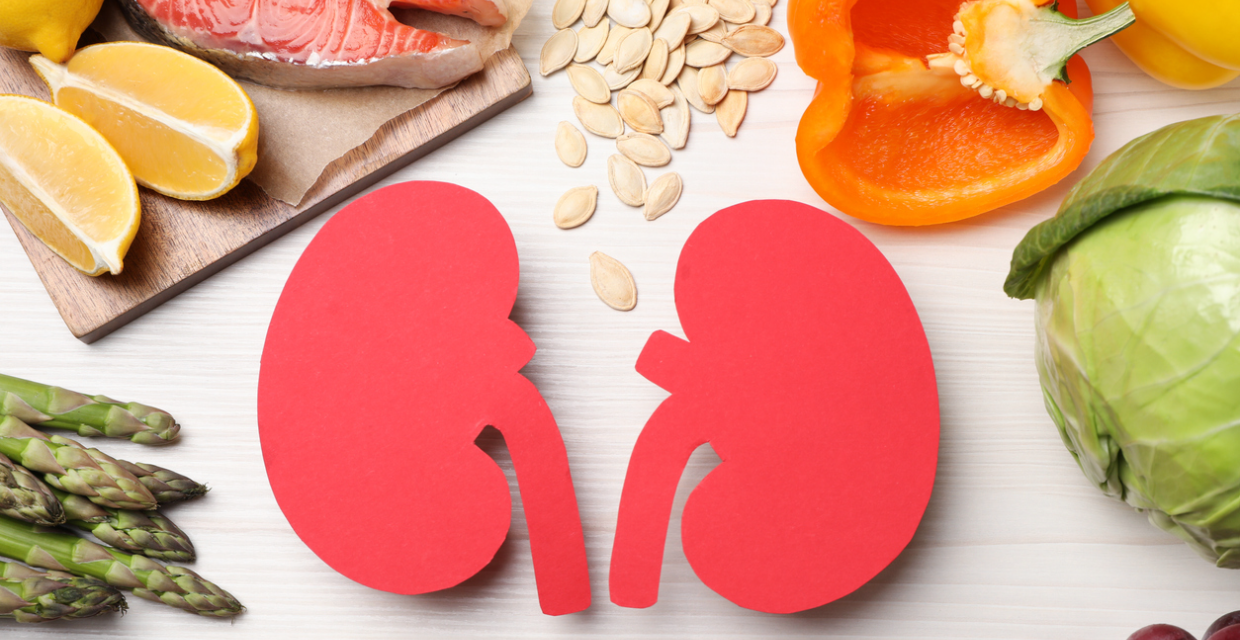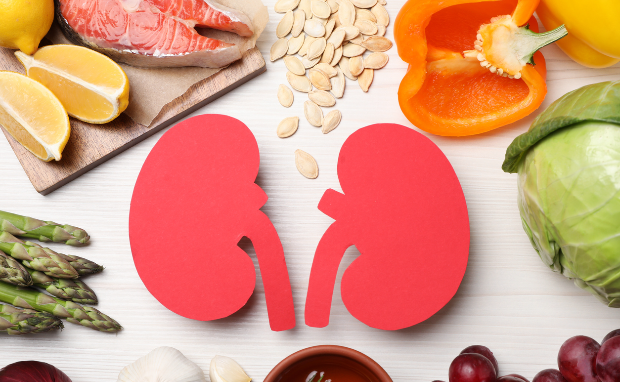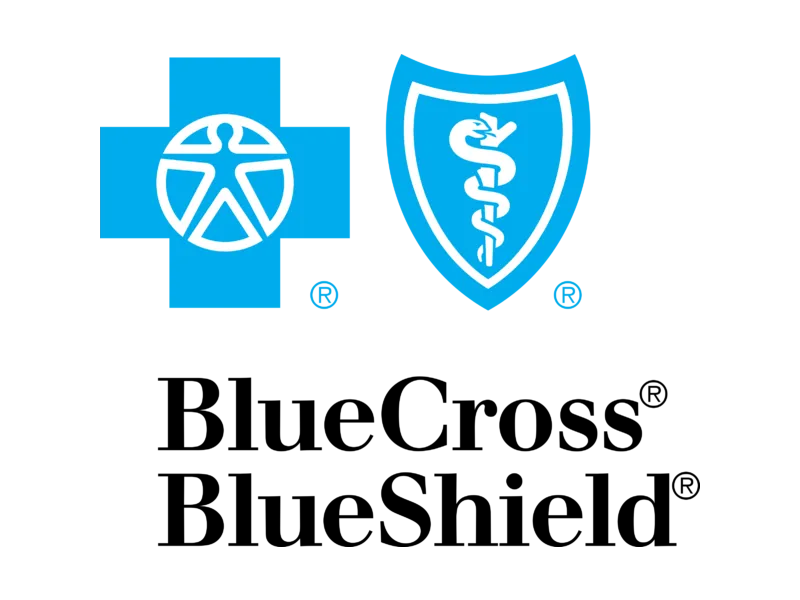Key Points
- A kidney-friendly diet focuses on managing sodium, phosphorus, and potassium to reduce strain on your kidneys
- Plant-based proteins and fresh foods are often gentler on the kidneys than processed foods with artificial additives
- Simple cooking techniques and flavorful herbs can make low-sodium meals both delicious and sustainable
Being diagnosed with kidney disease can feel overwhelming. Suddenly, you’re told to watch your diet like never before. The constant vigilance can lead to feelings of anxiety about making the “right” choices, cooking meals, and living with kidney disease.
Registered Dietitian, Daniel Chavez, RD, says, “One of the biggest challenges is learning how to balance nutrient restrictions while still enjoying meals and getting enough calories. Meal planning can feel overwhelming, especially when trying to manage cravings or eating out with friends and family. Travel, convenience foods, and changing energy levels can also make it difficult to stick to a kidney-friendly plan.”
The good news is that, with the right guidance, you can create meals that are both delicious and supportive of your kidney health. A kidney-friendly diet does not have to be bland or boring.
This guide will walk you through the key foods to focus on and limit, plus provide a practical, dietitian-approved 7-day meal plan to manage kidney disease.
What is chronic kidney disease (CKD)?
Chronic kidney disease occurs when your kidneys gradually lose their ability to filter waste and excess fluid from your blood effectively. This damage happens over time and can lead to a buildup of harmful substances in your body, potentially causing other health complications.
- In the early stages, CKD often presents no obvious symptoms, which is why it's sometimes called a "silent" disease.
- As the condition progresses, you may begin to notice fatigue, swelling in your hands, feet, ankles, or face, changes in urination patterns (such as urinating more frequently, especially at night, or producing foamy, dark, or bloody urine), persistent nausea, or difficulty concentrating.
Foods to eat and avoid for kidney disease
Chavez, RD says, “When someone has kidney disease, they often need to limit foods high in sodium, potassium, phosphorus, and protein to help protect kidney function and manage symptoms.”
The Standard American diet (SAD), which is high in red meat, processed foods, and salt and low in vegetables and fruit, can lead to inflammation and make the kidneys work overtime.
At a high level, it’s important to:
- Reduce salt intake to lower blood pressure and protein in urine
- Eat more whole fruits and vegetables
- Get enough dietary fiber to help protect the kidneys
The goal of a diet for CKD isn't just about restriction; it's about making nourishing choices that support your health without making your kidneys work overtime.
While adjusting to a new way of eating has its challenges, it's also an opportunity to discover new recipes and flavors.
Important note: These food recommendations and meal plans are general guidelines for educational purposes only. Individual needs vary based on your CKD stage, lab results, and health status. This is not medical advice. Always consult your healthcare provider and consider working with a registered dietitian before making dietary changes.
Foods to eat
- Low-sodium proteins: Skinless chicken breast, fish, egg whites, and tofu. Fish, like salmon, is particularly beneficial as it's rich in omega-3 fatty acids that may help reduce inflammation.
- Low-potassium fruits: Apples, berries (strawberries, blueberries, raspberries), grapes, pineapple, and plums.
- Low-potassium vegetables: Bell peppers, cabbage, cauliflower, cucumber, onions, lettuce, and radishes.
- Kidney-friendly grains: White rice, refined-flour pasta, and white bread are often recommended because they are lower in phosphorus and potassium.
- Healthy fats: Olive oil and small portions of unsalted nuts.
- Flavor enhancers: Garlic, onion, and a world of herbs and spices. Using herbs and spices is a fantastic way to add flavor without relying on salt.
Foods to limit
The following foods could burden your kidneys when consumed in excess. The goal is to reduce these foods based on your individual needs, under medical guidance.
- High-sodium foods: Canned soups, processed meats (bacon, sausage, deli meats), frozen dinners, fast food, and salty snacks like chips and pretzels. Excess sodium can increase blood pressure and make your kidneys work harder.
- High-potassium foods: Oranges, bananas, potatoes, tomatoes, spinach, and avocados.
- High-phosphorus foods: Dairy products (milk, cheese, yogurt), nuts, seeds, dried beans (like kidney beans and black beans), and whole-grain bread.
- Foods with phosphorus additives: Processed foods, colas, and some bottled teas often contain hidden phosphorus additives. Check labels for ingredients that include "phos" (e.g., phosphoric acid, sodium phosphate).
💡How to build your meal plan
Knowing what to eat is the first step. These simple strategies will help you put it all together for the best results.
1. Choose your protein
Protein is essential for maintaining muscle mass and overall health, but when your body processes protein, it produces waste products that your kidneys must filter. Consuming the right amount and type of protein helps prevent your kidneys from becoming overworked.
Focusing on high-quality protein sources in appropriate portion sizes is crucial. Plant-based proteins from foods like tofu and lentils may be gentler on your kidneys because they typically produce less acidic waste products during digestion.
Working with a registered dietitian can help you determine the ideal protein intake for your specific needs, as requirements vary based on your stage of kidney disease and individual health factors.
2. Understand your phosphorus sources
If you have kidney disease, phosphorus becomes a concern because damaged kidneys struggle to filter it out of your bloodstream. As phosphorus accumulates, your body steals calcium from your bones, leaving them fragile and prone to fractures.
The tricky part is that the source of phosphorus in your diet is important:
- Processed meat, packaged foods, and sodas are phosphorus bombs: The body absorbs over 90% of the artificial phosphorus that manufacturers add.
- Our bodies absorb 40-60% of animal-based phosphorus found in meat, dairy, and eggs.
- Meanwhile, the body absorbs less than 50% of plant-based phosphorus in foods like lentils and oatmeal, so these may be better choices.
You don’t have to avoid all phosphorus-based foods. Focus on fresh, whole foods and read ingredient lists carefully (anything with "PHOS" in the name is a red flag).
3. Tame the potassium in vegetables
Many healthy foods, like potatoes and spinach, are high in potassium, which can be a challenge for a kidney-friendly diet. But you might not have to give them up entirely.
A cooking technique called leaching can remove a significant amount of potassium. The National Kidney Foundation recommends a process of slicing, soaking, and boiling these vegetables to make them more kidney-friendly.
Your 7-day kidney disease meal plan
This sample meal plan is designed for individuals with stage 1-4 CKD who are not on dialysis, but every person's needs are unique. This is not personalized medical advice. Consult your healthcare provider and a registered dietitian before implementing any meal plan.
Feel free to swap meals and adjust portions based on your preferences. Fresh or dried herbs can add flavor without having to add more salt to your meals.
Day 1
Breakfast: Bell pepper and onion scramble. Scramble two egg whites with ½ cup of diced red bell peppers and ¼ cup of chopped onions, sautéed in olive oil, and add a pinch of paprika. Serve with one slice of white toast with unsalted butter.
Lunch: Crunchy chicken salad. Mix 3 oz of cooked, shredded chicken breast with ¼ cup diced celery, 1 tbsp chopped red onion, and 2 tbsp of plain Greek yogurt. Season with garlic powder and black pepper. Serve with a handful of low-sodium crackers and a side of red grapes.
🌱 Plant-based swap: Use cooked chickpeas (slightly mashed) instead of the chicken.
Dinner: Lemon-dill baked cod. Bake a 4-oz cod fillet seasoned with fresh dill, garlic powder, and a squeeze of lemon juice at 400°F for 12-15 minutes. Serve with 1 cup of steamed green beans and ½ cup of white rice.
Snacks: A small apple, rice cakes with a thin layer of cream cheese.
Day 2
Breakfast: Berry oatmeal. Cook ½ cup of quick-cooking oats with water. Top with ½ cup of mixed berries (strawberries, blueberries) and a sprinkle of cinnamon.
Lunch: Turkey and cucumber sandwich. Layer 3 oz of low-sodium sliced turkey on two slices of white bread with crisp cucumber slices and a smear of low-sodium mustard.
🌱 Plant-based swap: Smear hummus on white bread and add crisp cucumber slices on top
Dinner: Sheet pan lemon-herb chicken. Toss one boneless, skinless chicken breast (4 oz) and 1 cup of cauliflower florets with olive oil, dried oregano, and lemon juice. Roast at 400°F for 20-25 minutes. Serve with ½ cup of refined-flour pasta.
🌱 Plant-based swap: Use tempeh (fermented soybean) with the cauliflower florets.
Snacks: A small pear, a handful of unsalted pretzels.
Day 3
Breakfast: Fruity Greek yogurt bowl. Stir ½ cup of plain Greek yogurt with ¼ cup of sliced peaches and 1 tbsp of slivered almonds. The small amount of almonds provides healthy fat, and because their phosphorus is plant-based, it's less readily absorbed.
Lunch: Simple tuna salad lettuce wraps. Mix one 3 oz can of no-salt-added tuna (drained) with 1 tbsp of mayonnaise, chopped celery, and a pinch of dill. Scoop into large lettuce leaves.
🌱 Plant-based swap: Swap cooked white beans (lightly mashed) for the tuna
Dinner: Savory ground turkey and rice. Brown 4 oz of lean ground turkey with minced garlic and onion powder. Stir in ½ cup of cooked white rice and 1 cup of cooked chopped cabbage. Season with a salt-free herb blend.
🌱 Plant-based swap: Use cooked green lentils instead of the ground turkey.
Snacks: A small bowl of pineapple chunks, cucumber slices.
Day 4
Breakfast: Refined-flour pancakes with raspberry sauce. Top two small pancakes with a simple sauce made by warming ¼ cup of frozen raspberries. For a bit of sweetness, add a very small drizzle of honey or agave, but focus on the fruit for flavor.
Lunch: Chicken and veggie skewers. Thread cubed chicken breast (3 oz) with chunks of red bell pepper and zucchini onto skewers. Brush with olive oil seasoned with garlic powder and oregano, then grill or bake until cooked through.
🌱 Plant-based swap: Skewer firm tofu cubes and veggies instead of the chicken.
Dinner: Pan-seared salmon with roasted asparagus. Pan-sear a 4-oz salmon fillet in a little olive oil. Serve with a side of roasted asparagus spears (about six spears) tossed in olive oil and garlic powder. You can use steamed green beans instead of asparagus, if you prefer.
🌱 Plant-based swap: Sautee mixed veggies like zucchini, bell peppers, and carrots for a colorful stir-fry. You can still have the asparagus on the side, if you prefer.
Snacks: A small plum, a small bowl of strawberries.
Day 5
Breakfast: Cream of wheat with a flavor swirl. Prepare ½ cup of cream of wheat according to package directions using water. Add a pinch of ground ginger or cardamom for a different warm, spicy flavor.
Lunch: Roast beef and arugula sandwich. Place 2-3 slices of low-sodium roast beef on sourdough bread with a handful of fresh arugula, thinly sliced red onion, and a spread made from plain Greek yogurt mixed with a pinch of dill.
🌱 Plant-based swap: Use sautéed mushrooms instead of the beef.
Dinner: Tofu stir-fry with ginger and garlic. Stir-fry ½ block of firm, cubed tofu with sliced mushrooms and green beans in sesame oil with fresh minced ginger and garlic. Add a splash of low-sodium soy sauce or tamari for flavor. Serve over ½ cup of white rice.
Snacks: Red grapes, 3-4 unsalted saltine crackers with a thin layer of unsalted butter.
Day 6
Breakfast: Hearty English muffin scramble. Scramble two egg whites with sautéed diced bell peppers and onions. Serve on a toasted whole white English muffin.
Lunch: Cold pasta salad. Toss ½ cup of cooked pasta with diced cucumber, red bell pepper, and a light vinaigrette made from olive oil, red wine vinegar, and a pinch of dried oregano.
Dinner: Savory chicken and vegetable soup. Simmer 3 oz of diced chicken breast in 2 cups of low-sodium chicken broth with a low-potassium vegetable mix (carrots, celery, corn). Season with thyme and black pepper.
🌱 Plant-based swap: Cook white beans in low-sodium vegetable broth with carrots, celery, and corn.
Snacks: A small apple with 1 tbsp of unsalted peanut butter, a small bowl of blueberries.
Day 7
Breakfast: Blueberry smoothie. Blend ½ cup of frozen blueberries, ½ cup of rice milk, and ¼ cup of silken tofu until smooth for a protein boost.
Lunch: Shrimp and cabbage slaw. Toss 3 oz of cooked shrimp with 1 cup of shredded cabbage, shredded carrots, and a dressing made from rice vinegar and a dash of sesame oil.
🌱 Plant-based swap: Use steamed edamame instead of the shrimp.
Dinner: Rosemary chicken thighs with cauliflower mash. Roast one 4 oz skinless chicken thigh seasoned with dried rosemary and garlic powder at 400°F for 25-30 minutes. Serve with a side of steamed cauliflower mashed with a little unsalted butter and chives.
🌱 Plant-based swap: Season and use tempeh instead of the chicken thighs.
Snacks: Watermelon chunks, low-sodium tortilla chips with a fresh salsa made from finely diced cucumber, red bell pepper, red onion, and cilantro.
What does a dietitian do for kidney disease?
“A registered dietitian specializing in renal nutrition can personalize a meal plan that fits the individual’s stage of kidney disease, lab values, and lifestyle,” explains Chavez, RD. “Instead of relying on generic lists or trial and error, they provide evidence-based guidance and practical tools for managing meals, snacks, and eating out. This support can reduce stress and help people feel more in control of their health.”
Final thoughts: Kidney disease meal plan
Adjusting to a kidney-friendly diet is a gradual process of learning and adaptation. This 7-day meal plan is designed to give you an idea of the types of meals you can eat with kidney disease.
The most effective diet for kidney disease is one that is tailored to your unique needs, which can change over time. Working closely with a healthcare provider and a registered dietitian can help you get personalized guidance to protect your kidneys.
Get your personalized kidney disease meal plan now, covered by insurance.
Frequently Asked Questions (FAQs)
Can I eat eggs with kidney disease?
Yes, you can generally eat eggs with kidney disease, but moderation is key. Egg whites are an excellent choice as they are pure, high-quality protein and very low in phosphorus. Egg yolks contain more phosphorus, so your doctor or dietitian may advise limiting them based on your lab results.
Is a plant-based diet good for kidney disease?
A diet that emphasizes plant-based foods can be very beneficial for kidney health. Studies suggest that plant-based proteins can help reduce the acid load on the kidneys and may slow the progression of CKD compared to diets high in animal protein.
Why is white bread recommended over whole wheat for a kidney diet?
White bread is often recommended for people with kidney disease because it's lower in phosphorus and potassium. While your body doesn't absorb all the phosphorus from whole grains, the higher amounts can still be a concern for some people with CKD. A renal dietitian can look at your specific lab values and help you decide if you can safely include small amounts of whole grains in your diet.
Find a kidney disease dietitian who accepts your insurance.
The views expressed by authors and contributors of such content are not endorsed or approved by Fay and are intended for informational purposes only. The content is reviewed by Fay only to confirm educational value and audience interest. You are encouraged to discuss any questions that you may have about your health with a healthcare provider.
Sources
Fay Nutrition has strict sourcing guidelines and relies on peer-reviewed studies, academic research institutions, and medical associations. We avoid using tertiary references.
- Chronic Kidney Disease Diagnosis and Management: A Review (October 01, 2020)
https://pmc.ncbi.nlm.nih.gov/articles/PMC7015670/ - Chronic Kidney Disease: The Silent Epidemy (October 26, 2019)
https://pmc.ncbi.nlm.nih.gov/articles/PMC6912263/ - Diet and Chronic Kidney Disease (November 15, 2019)
https://pmc.ncbi.nlm.nih.gov/articles/PMC6855949/ - ‘Phos’tering a Clear Message: The Evolution of Dietary Phosphorus Management in Chronic Kidney Disease (June 19, 2023)
https://pmc.ncbi.nlm.nih.gov/articles/PMC10728341/ - Potassium in Your CKD Diet (May 05, 2023)
https://www.kidney.org/kidney-topics/potassium-your-ckd-diet - Chronic Kidney Disease and Dietary Measures to Improve Outcomes (February 01, 2020)
https://pmc.ncbi.nlm.nih.gov/articles/PMC6623973/











